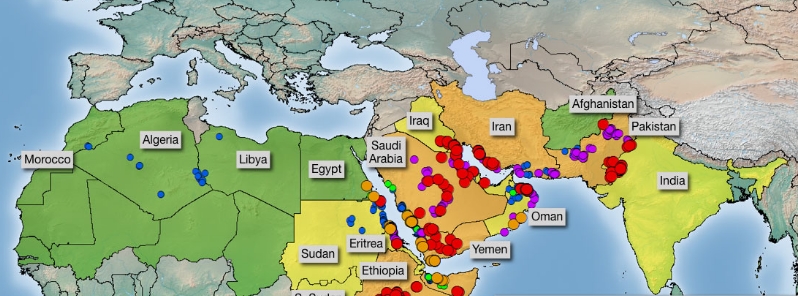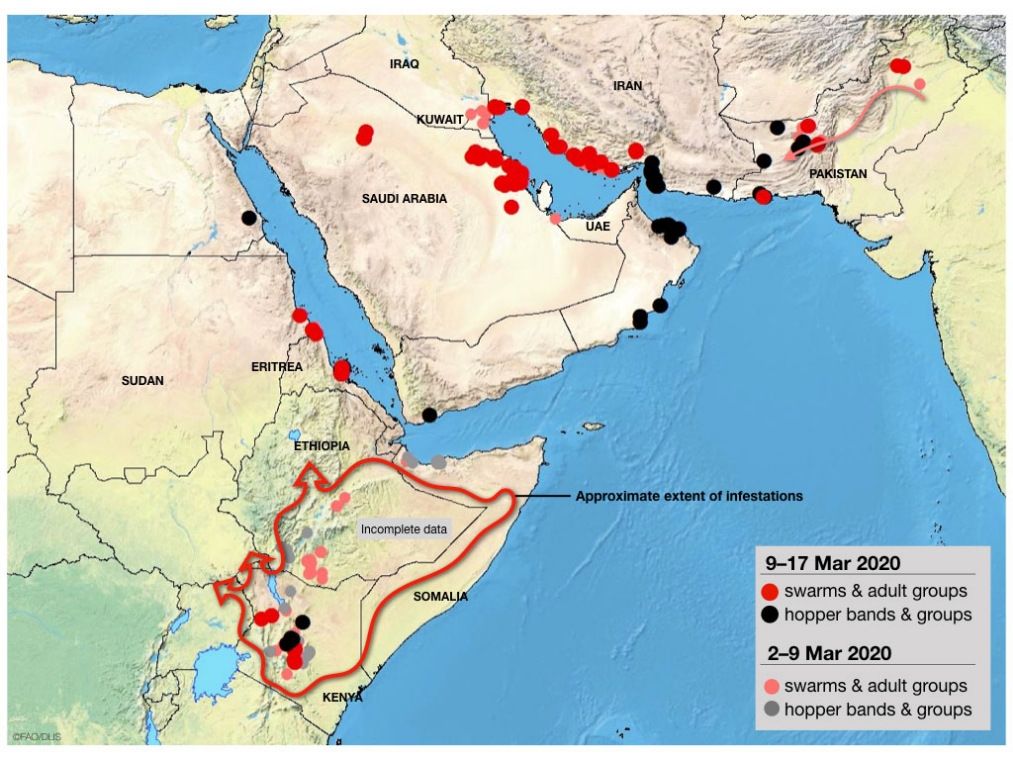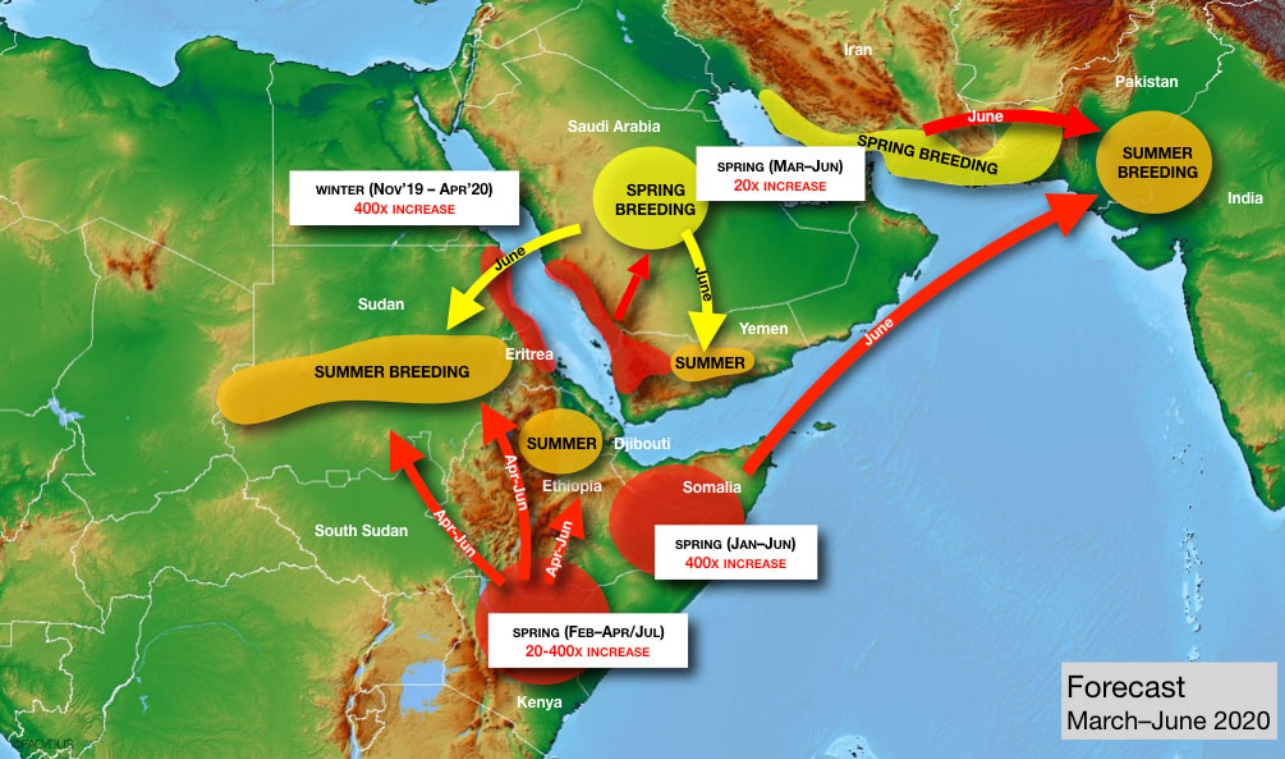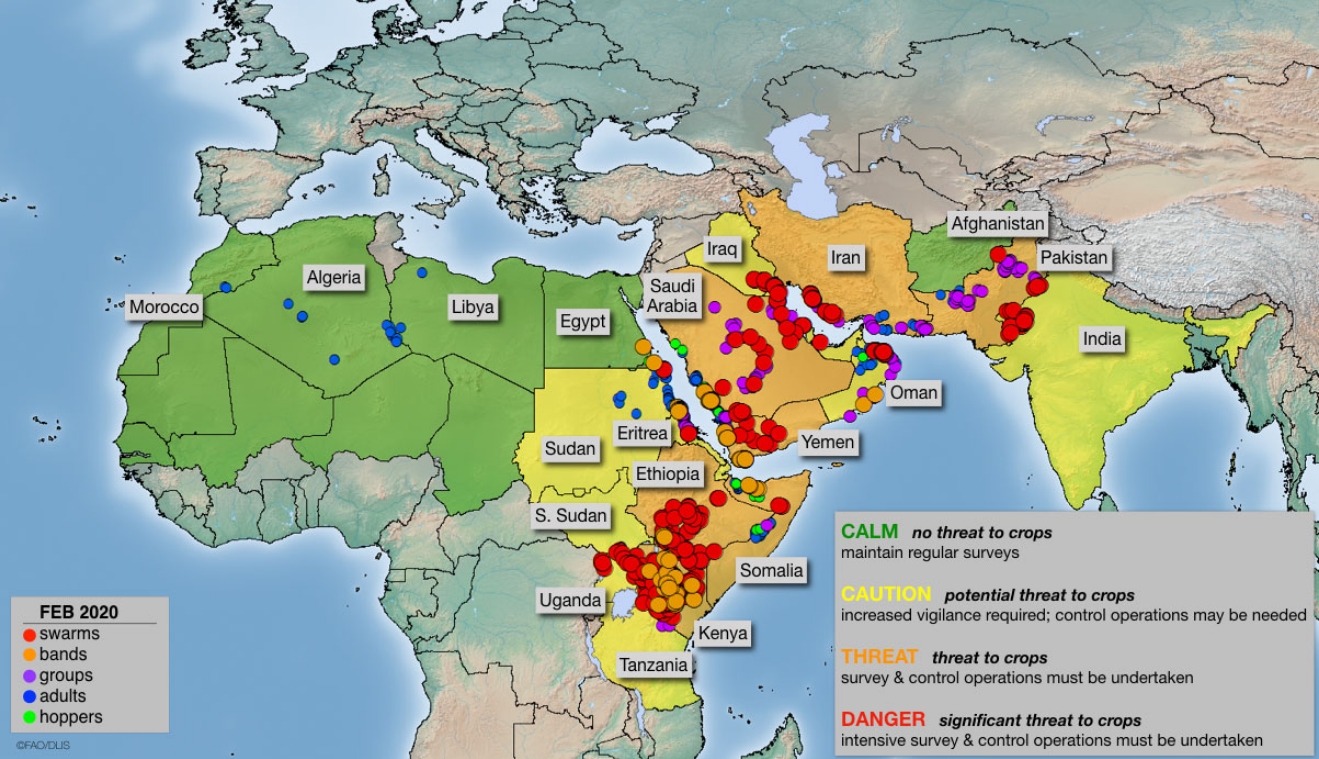Desert locust outbreak remains extremely alarming, new swarms continue forming and invading Africa and Middle East

Desert locust plague situation remains extremely alarming as new swarms continue forming and invading parts of Africa and the Middle East. The United Nation's Food and Agriculture Organization (FAO) said that the outbreak poses an unprecedented threat to food security and livelihoods at the start of the upcoming crop season.
The situation remains extremely alarming in the Horn of Africa, specifically Kenya, Ethiopia and Somalia where widespread breeding is in progress and new swarms are starting to form, representing an unprecedented threat to food security and livelihoods at the beginning of the upcoming cropping season, FAO said in Desert Locust situation update published March 17, 2020.
The desert locusts that have been wreaking havoc in massive swaths of East Africa, Pakistan, and Iran are expected to further spread and worsen as new swarms started to form in the Horn of Africa.
According to FAO's report, the countries predicted to be affected the worst are Kenya, Ethiopia, Somalia, and Sudan. Other countries such as Eritrea, Egypt, Yemen, Saudi Arabia, and Oman also have cases.

Current situation report. Image credit: FAO
In Kenya, hopper bands continue to develop and form an increasing number of first-generation immature swarms in northern and central counties. Further concentration are expected in Marsabit and Turkana. Aerial and ground control operations continue.
While there are no new information coming from Ethiopia, hopper bands continue to form within a widespread area of Oromiya and SNNPR regions, including the Rift Valley. A new generation of immature swarms are likely to have started forming in some areas. Aerial and ground control operations continue.
Hopper bands forming on the southern coast near Aden, Yemen where control was carried out. The situation is not well known in other areas where breeding is likely underway.
Swarms and adult groups continue laying eggs in the southwest Iran (southern Khuzestan, Bushehr, southern Fars, western Hormozgan provinces). Hatching and band formation imminent. Local breeding continues in the southeast where hoppers are forming groups and bands in eastern Hormozgan. Control operations are in progress.
The situation is under control in the following countries: Sudan, Eritrea, Egypt, Saudi Arabia, and Oman.
In Sudan, two immature swarms appeared on the southern coast of the Red Sea on March 14. Scattered adults along parts of the coast.
Conditions are drying out on the central and northern coast of Eritrea. Control operations continue against groups of late instar hoppers and immature adults on the Buri Peninsula and in the Dahlak Islands.
In Egypt, late instar hopper groups are treated at one place on the Red Sea coast in the southeast.
Control operations against one mature swarm and groups of laying adult near the Persian Gulf between Al Hofuf and Kuwait in Saudi Arabia, and a few mature groups in the northern interior south of Al Jawf.
Hatching on the north coast and control operations against early instar hopper groups are in progress in Oman, and continue against late instar hopper groups on the east coast.

Locust outbreak forecast. Image credit: FAO
The present widespread breeding in Kenya, Ethiopia, and Somalia continues to pose unprecedented threats to food security and livelihoods, said FAO on the Locust Watch website.
FAO has warned about these threats last month while appealing for prompt support, calling on international groups and organizations to help in combatting the swarms.

Locust risk. Image credit: FAO
Featured image credit: FAO

My daughter is in Muscat and she sent me a video of a video of Locust invasion on her lawns and around them there.
You guys have not studied ENOUGH….some of us REALLY know what the WHOLE deal is- not the fragments they want you to analyse and come up with the conclusion/ logic” they want you to come up with.
A normal comment would be to share what you know.
BLOW TORCHES FOR EVERYONE
Elon’s is on it…if Tesla can produce enough flamethrowers
Locusts: Ex. 10:1–20
If you refuse to let them go, I will bring locusts into your country tomorrow. They will cover the face of the ground so that it cannot be seen. They will devour what little you have left after the hail, including every tree that is growing in your fields.
Get a grip.
The game has changed.
Patricia Berner,
Would you care to explain? I’d be very interested to know what you mean by “the game has changed”?
Israelites are not being held any longer. Centuries old situation re: Exodus 10.
I really wish they’d add a feature on here to notify a person via email that they’ve received a response to their post. I mean it’s not too hard to do. Anyway back to you Dena, I disagree with your take on Israel, they haven’t been ‘free’ since they first returned to the land they were banished from, or really long before that even. They’re always being chased out and ostracized everywhere they go (eventually). That’s their history since their days of bondage in Egypt. Look at the world now, the Jewish people are having to leave their homes in other nations to return to Israel because of the insane increase of antisemitism going on…AGAIN. Nope, they’re not free, not yet.